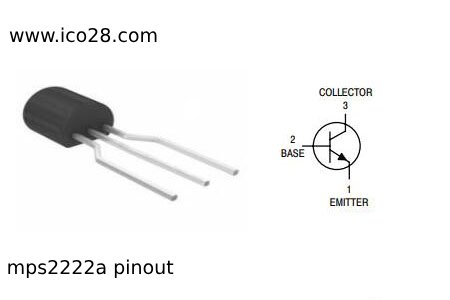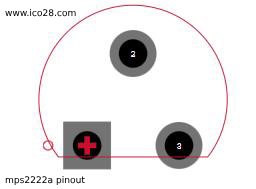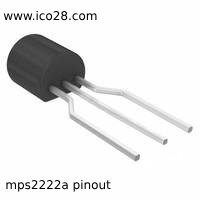I. Introduction
In electronic circuits, the MPS2222A bipolar junction transistor (BJT) is a popular choice due to its dependability and adaptability. It is frequently used in many applications, including signal processing, switching, and amplification. It is a member of the NPN transistor family.
A. Overview of the MPS2222A transistor
Three terminals are present on the MPS2222A transistor: the emitter, base, and collector. These terminals are very important because they control how the transistor behaves in a circuit. When a voltage is supplied across the base-emitter junction of an NPN transistor, current flows from the emitter to the collector. Because of this, depending on its configuration and circuit design, the transistor can either operate as a switch or magnify signals.

B. Importance of understanding its pinout
The pinout provides valuable information about the internal connections of the transistor, including the arrangement of its terminals and their corresponding functions. By comprehending the pinout, one can effectively integrate the MPS2222A into circuit designs, ensure proper connections, and optimize its performance.
II. What is a Pinout?
A. Definition and significance
In electronics, a pinout is the arrangement and description of pins or terminals on an electrical component, such as a transistor or integrated circuit. It shows a clear mapping of each pin’s purpose and connectivity inside the device. Pinouts are crucial documentation for engineers and technicians, allowing them to understand how to correctly interact with components. They specify critical parameters such as power supply connections, signal inputs and outputs, and other information required to incorporate the component into a circuit design.
B. Importance in electronic circuits
Pinouts play a key role in the design, construction, and troubleshooting of electronic circuits. They provide a standardized method of identifying and connecting components, allowing for greater interoperability and compatibility among devices. Engineers can avoid costly mistakes during circuit assembly by learning the pinout of each component. Pinouts also serve as a reference point for circuit analysis and debugging, allowing engineers to accurately trace signal routes and diagnose errors.
III. Exploring the MPS2222A Pinout
A. Pin configuration diagram
The MPS2222A transistor’s pin configuration diagram shows how its terminals are arranged and labeled, giving a visual depiction of the actual construction of the transistor. Users can guarantee precise connections and prevent wiring errors during circuit assembly by consulting the pin configuration diagram, which enhances the general functioning and dependability of electronic systems that contain the MPS2222A transistor.

B. Identification of each pin
Engineers are able to identify the purpose of every pin—emitter, base, or collector—by closely examining the pinout data. Through accurate connection of external parts, such as power supply, signal sources, or load devices, made possible by this identification procedure, the transistor is guaranteed to function as intended within the circuit design.
C. Functions and roles of different pins
The base terminal regulates the flow of these charge carriers, which in turn controls the conductivity of the transistor. The emitter terminal is in charge of emitting charge carriers into the transistor. The circuit path is finished when the collector terminal gathers the charge carriers. Through an understanding of the unique purposes of each pin as described in the pinout specification, engineers may optimize performance and reliability by designing circuits that meet the demands of particular applications.
IV. Understanding Pin Connections
A. How to interpret the pinout diagram
Interpreting the pinout diagram of a component like the MPS2222A transistor involves understanding the symbols and labels used to represent each pin. To accurately interpret these diagrams, engineers usually consult datasheets or other technical literature supplied by the manufacturer. The pin configuration and their associated functions within the device can be ascertained by examining the diagram. This understanding is crucial for correctly identifying and connecting the pins during circuit design and assembly, ensuring proper operation and performance.
B. Making connections in circuits
Making connections in circuits involves physically wiring the pins of electronic components according to their specified connections outlined in the pinout diagram. Engineers utilize various techniques such as soldering, wire wrapping, or breadboarding to establish these connections effectively. They might also use terminal blocks or connectors to make it simple and safe to attach wires or other components.

C. Common mistakes and troubleshooting tips
Misreading the pinout diagram, improper wiring, poor soldering, and component breakage from extreme heat or mechanical stress are a few examples of these. Engineers use troubleshooting procedures including continuity testing, voltage measurements, and visual inspection of connections to remedy such difficulties. Additionally, referencing datasheets, consulting with colleagues or online resources, and double-checking connections can help identify and rectify mistakes effectively.
V. Practical Applications
A. Examples of circuits using the MPS2222A
The transistor is frequently utilized in amplifier circuits to amplify weak signals. The MPS2222A is also used in switching circuits, where it functions as a control element to switch devices on or off in response to predetermined parameters. Another example is in oscillator circuits, where the transistor generates oscillations for use in radio frequency (RF) or audio applications.
B. How understanding pinout aids in circuit design
Comprehending the pinout of the MPS2222A transistor is very helpful for circuit design since it makes it clear how to incorporate the transistor into the circuit in an efficient manner. By using this knowledge, engineers may ensure that the circuit operates correctly by figuring out the correct connections for the emitter, base, and collector terminals. Engineers can minimize signal distortion, maximize circuit performance, and accomplish desired functionality using this expertise. Moreover, knowing the pinout facilitates efficient placement of the transistor within the circuit layout, contributing to overall design efficiency and reliability.

C. Real-world scenarios and case studies
In real-world scenarios, engineers encounter various challenges and constraints when designing circuits using components like the MPS2222A transistor. Case studies offer insights into how understanding the pinout can impact circuit performance and functionality. For instance, a case study might explore the design of a low-noise amplifier for a communication system and demonstrate how correctly interpreting the pinout leads to improved signal quality and reduced interference. Another scenario could involve the development of a power management circuit, highlighting how precise pin connections enhance efficiency and reliability. These case studies provide practical examples of the importance of pinout understanding in real-world circuit design.
VI. Conclusion
A. Importance of mastering the MPS2222A pinout
A thorough comprehension minimizes errors and improves overall system reliability by enabling exact integration into electronic circuitry. An engineer can more efficiently accomplish their design goals when they have a thorough understanding of pinouts, which makes circuit design, assembly, and troubleshooting more efficient. Additionally, becoming proficient with the MPS2222A pinout builds confidence while handling electronic components, which paves the way for more complex projects and advancements in the field of electronics.
B. Future applications and learning opportunities
In terms of the future, becoming proficient with the MPS2222A pinout provides access to a wealth of new applications and educational prospects. Engineers can use this information to create creative circuit designs for a variety of uses, such as industrial automation and consumer electronics. Moreover, there are always new prospects for experimentation and skill improvement due to the constant progress in electronics. Engineers can continuously grow their areas of expertise and make contributions to the field’s growth by keeping up with changing trends and technologies.
